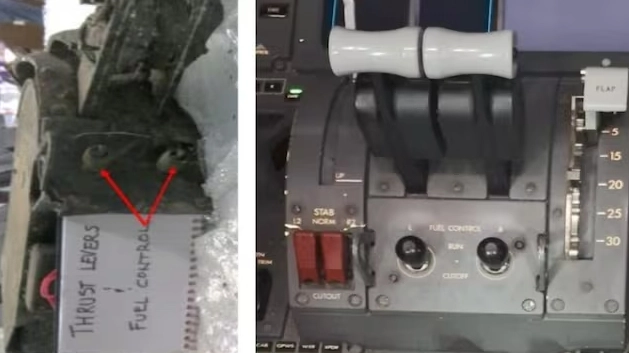
As the initial report on the Air India-171 crash drew criticism, the investigators are probing whether the Stabiliser Position Transducer malfunction, detected and dealt with hours before the crash, led to multiple sensor failures, which whichpossibly triggered “un-commanded" actions in the aircraft, according to a report.
Hours before the Ahmedabad to London Gatwick flight took off on June 12, a pilot flying the same plane from Delhi to Ahmedabad noted in the technical log a ‘Stabiliser Position Transducer Defect’, an official told The Indian Express.
The Stabiliser Position Transducer is a sensor that helps control the aeroplane’s pitch — the up and down movement of the nose. It sends electrical signals to the flight control system to ensure that the aircraft responds correctly to the pilot’s commands. The official said that the malfunction was checked, and the engineer did the troubleshooting according to Boeing’s procedures.
“The malfunction is a critical issue as it can trigger incorrect responses in flight control, including unintended fuel cut-off signal," the official said, adding that the Stabiliserr Position Transducer malfunction did not cause this crash, “but the question is whether it led to multiple sensor failures".
The official told the newspaper that the probe of the snags that were recorded in the electrical and software components of the AI-171 will ascertain the possibility of an “un-commanded transition" of the fuel control switches to the cut-off mode seconds after the flight was airborne.
The flight had crashed seconds after takeoff on June 12, killing 241 people on board. The initial report published by the AAIB suggested the dual-engine shutdown as the cause of the crash, as per which, the fuel control switch was moved from ‘Run’ to ‘Cutoff’ position within a span of one second. The ‘Run’ position was reinstated by the pilots; however, the aircraft crashed seconds later.
The preliminary report published by the Aircraft Accident Investigation Bureau (AAIB) and put out in the public domain by the government had mentioned the brief exchange between the two pilots moments before the plane crash. The interaction was regarding the “transition" of the fuel control switches that allow and cut the supply of fuel to the engines. “In the cockpit voice recording, one of the pilots is heard asking the other why he cut off. The other pilot responded that he did not do so," the report said. The pilots’ association criticised the report, stating that the probe was being done presuming that the pilots were at fault.
As per the newspaper, the same flight was involved in two more incidents – one relating to electrical snags in the aircraft, leading to flight cancellation, and another related to a false fuel system warning flashing on the screen of the plane. The official said that analysis of flight data would focus on the “trail of errors" mentioned in the technical logs to check the condition of the aircraft’s electrical and software systems.
According to the official, the plane had experienced two major snags earlier, one of which led to a flight cancellation due to an “unresolvable electrical snag" in December 2024. The other was an emergency landing way back in 2015 due to a Cabin Air Compressor surge, a known issue on the Boeing 787-8 Dreamliner.
“On December 12, 2024, incidentally, the same AI-171 scheduled flight from Ahmedabad to Gatwick could not take off as it experienced a massive technical snag that led Air India to abort boarding… The issue was an electrical failure that had been indicated in the incoming flight from Delhi. The flight took off the next day, on December 13, after the issue was resolved… A day prior, it had made a round trip between Delhi and Zurich, and no snags were reported," the official told the newspaper.
Explaining how things would have gone on in the ill-fated Air India plane that day, the official said, “The AI-171 pilots had performed the functions of take-off, consistent with the protocols, right from a pulled back yoke to the flap handle assembly, thrust levers as seen in the wreckage… the aircraft lifted off to initiate the climb after reaching Vr speed when the sensors switched to the ‘air’ mode. Whether electric failure or software bug led to un-commanded actions and resulted in an engine failure within seconds, causing a loud bang, deployment of the RAT and the transition of the fuel switches to cut-off mode… given the sensor snag reported in the prior flight, we cannot overlook the possibility of a system error that resulted in the unexplained transition."
“The probe is on to ascertain if the switch locks were disengaged due to an anomaly or if the FADEC’s (Full Authority Digital Engine Control) Engine Control Unit (the brain of the aircraft) malfunctioned as the microprocessor could have misinterpreted the commands and initiated uncontrolled actions," he added.